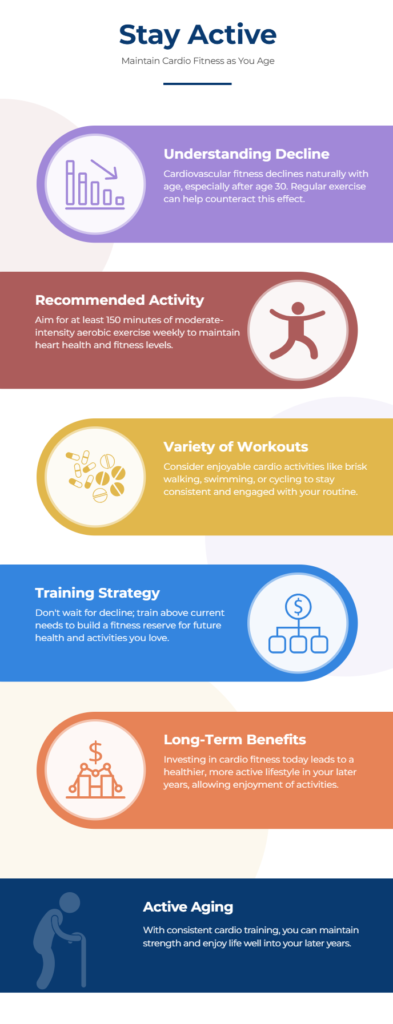Don’t miss a post. Click here to sign up for our free newsletter.
Estimated reading time: 4 minutes
Cardio Fitness
Have you ever wondered why some people seem to stay active and energetic well into their later years while others slow down dramatically? A major factor is cardiovascular fitness.
Our cardio capacity naturally declines as we age, but that doesn’t mean we’re powerless to stop it. In fact, with consistent effort, we can maintain and even improve our endurance, ensuring that we continue to enjoy the activities we love for decades to come.
The Reality of Cardiovascular Decline
As we get older, our VO2 max—the maximum amount of oxygen our bodies can use during exercise—decreases. Studies show that VO2 max declines at about 10% per decade after age 30 if we do nothing to counteract it. For highly active individuals, the decline is lower, around 5% per decade. This means that someone with a VO2 max of 45 ml/kg/min at age 30 could see it drop to around 30 ml/kg/min by age 60 if they don’t actively train their cardiovascular system.
Why does this matter? A lower VO2 max means reduced stamina, which makes everyday tasks more tiring and prevents us from enjoying activities like hiking, skiing, biking, or even playing with grandchildren. The good news? Regular cardio training can slow this decline significantly and, in some cases, even improve VO2 max.
How Much Cardio Do You Need?
The American Heart Association (AHA) and the Centers for Disease Control and Prevention (CDC) recommend that adults aim for at least 150 minutes of moderate-intensity aerobic exercise (such as brisk walking, swimming, or cycling) or 75 minutes of vigorous-intensity exercise (such as running or high-intensity interval training) per week.
For even greater benefits, doubling that amount—300 minutes of moderate-intensity or 150 minutes of vigorous activity per week—has been shown to further reduce the risks of heart disease, cognitive decline, and mobility issues.
The key is consistency. Even small amounts of exercise can have compounding benefits over time.
The Best Cardio Workouts for Lifelong Fitness
The best cardio workout is one that you enjoy and can stick with. Whether it’s running, cycling, rowing, swimming, or even a VR fitness game, the most crucial factor is adherence. Here are some great options to consider:
- Brisk Walking – Simple, low impact, and accessible to almost everyone.
- Running or Jogging – Excellent for building endurance and improving VO2 max.
- Cycling – Low impact but highly effective for cardiovascular health.
- Rowing – A full-body workout that challenges the heart and lungs.
- Aerobics and Dance Classes – Fun and engaging ways to stay active.
- VR Workouts – A new and exciting way to make cardio fun.
Train Today for Tomorrow
A common mistake is waiting until cardio fitness declines before taking action. The best strategy is to train at a level above what you currently need. This way, as you age, you’ll still have the strength and endurance to do the things you love. Think of it as a fitness savings account—you invest in your health today to withdraw those benefits later in life.
Imagine being able to hike with ease at 70 because you maintained strong cardio fitness in your 50s. Or still being able to bike long distances, ski, or dance well into your later years. It’s all possible with the right approach.
Join the Discussion!
What’s your favorite way to keep your cardio fitness strong? Have you noticed changes in your endurance over the years? Let’s start a conversation—share your experiences, tips, and questions in the comments!
By staying active today, we ensure a healthier, more vibrant tomorrow. Let’s keep moving!
Check out The Seven Pillars of Sustainable Health and Wellness, an introduction to our overall wellness coaching strategy.
Subscribe to our free newsletter to receive more health tips right in your inbox, or schedule a free 30-minute 1:1 call for a personal consultation.
Cardio Fitness | Cheat Sheet

